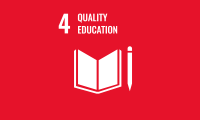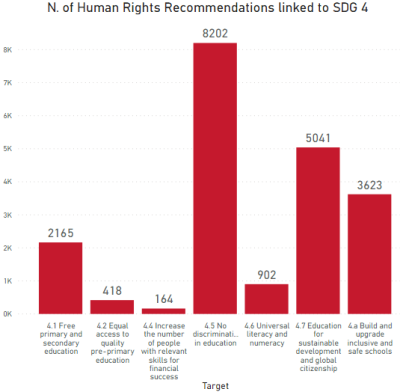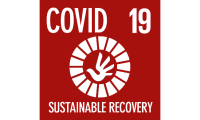SDG 4 and Sustainable Recovery

Key aspects of SDG 4:
1. Ensure free, equitable and quality education (including vocational training) for all (multiple targets under SDG 4)
The pandemic has undermined and reversed gains in the realization of the right to education on a global scale – and especially in countries where remote learning has not been possible. More than 90% of the total number of school children in the world have been directly affected by school closures due to the pandemic.
The pandemic exacerbates pre-existing education disparities by reducing the opportunities for many of the most vulnerable children, youth and adults to continue their learning – including those living in poor or rural areas, girls, refugees, persons with disabilities and forcibly displaced persons. Remote education programmes can discriminate and amplify existing learning inequalities, causing children from poorer households who do not have access to internet and electronics to fall behind (31% cannot receive learning through digital channels).
School closures put adolescent girls at increased risk of different forms of abuse including early and forced marriages and sexual abuse.
Past failure to build strong and resilient education systems has opened the door for a dramatic impact on the most vulnerable and marginalized, to which no temporary measure, (high- or low-tech) adopted in haste could have fully responded. Austerity measures and budget cuts to public education systems in many countries have weakened their capacity to cope with the education crisis. There is a risk that economic crises and indebtedness will lead to further decisions to reduce education budgets with negative impacts on education quality and access.
Sustainable response and recovery actions:
Countries should seek equitable solutions and universal access to education to prevent a learning crisis from becoming a generational catastrophe. This calls for greater focus on equity and inclusion; addressing learning losses and preventing dropouts, particularly of marginalized groups who are falling further behind; supporting the teaching profession; strengthening capacities for risk management, at all levels; strong leadership and coordination; and consultation and communication mechanisms.
Education financing must be protected, and international financial institutions must allow countries the fiscal space to make the necessary investment in public services, including education.
The UN Special Rapporteur on education has pointed to the need to unpack, in each local context, the dynamics at play that have led to increased discrimination in the enjoyment of the right to education during the crisis. It should include an analysis of rising inequalities due to the measures adopted to face the pandemic; an investigation into the sustainability of economic and financial models behind education systems, including the consequences of poor funding of public educational institutions; a scrutiny of the role of private actors in education; an evaluation of the adequacy of social protection provided for education workers, including in the private sector; and scrutiny of the lack of cooperation between state administrations, educational institutions, teachers, learners, parents and communities.
The UN Special Rapporteur on Education has pointed out that the deployment of online distance learning (together with radio and television), should only be seen as a temporary solution aimed at addressing a crisis. The digitalization of education should never replace onsite schooling with teachers, and the massive arrival of private actors through digital technology should be considered a danger for education systems and the right to education for all in the long term.
Visit the documents and resources listed in the “Key Human Rights Guidance” below for more information.
Universal Declaration of Human Rights (UDHR), art. 26.1: Everyone has the right to education. Education shall be free, at least in the elementary and fundamental stages. Elementary education shall be compulsory. Technical and professional education shall be made generally available and higher education shall be equally accessible to all on the basis of merit.
International Covenant on Economic, Social and Cultural Rights (ICESCR), art. 13.1: The States Parties to the present Covenant recognize the right of everyone to education. […]
International Covenant on Economic, Social and Cultural Rights (ICESCR), art. 13.2.a: Primary education shall be compulsory and available free to all;
International Covenant on Economic, Social and Cultural Rights (ICESCR), art. 13.2.b: Secondary education in its different forms, including technical and vocational secondary education, shall be made generally available and accessible to all by every appropriate means, and in particular by the progressive introduction of free education.
International Covenant on Economic, Social and Cultural Rights (ICESCR), art. 13.2.d: Fundamental education shall be encouraged or intensified as far as possible for those persons who have not received or completed the whole period of their primary education.
Convention on the Rights of Persons with Disabilities (CPRD), art. 24.1: States Parties recognize the right of persons with disabilities to education. With a view to realizing this right without discrimination and on the basis of equal opportunity, States Parties shall ensure an inclusive education system at all levels and life long learning directed to:
24.2 In realizing this right, States Parties shall ensure that:
24.2.a Persons with disabilities are not excluded from the general education system on the basis of disability, and that children with disabilities are not excluded from free and compulsory primary education, or from secondary education, on the basis of disability.
2. Ensure human rights education (target 4.7) as the foundation to support societies to build back better
The COVID-19 pandemic has disrupted the realization of economic, social, cultural, civil and political rights alike, and many societies have seen increased stigmatization of certain population groups. The knowledge and skills to claim one’s rights and to respect and uphold the rights of others are fundamental to human rights realization. Human rights education is key in this regard, and with its inherent human rights impacts, the pandemic has reinforced the need to prioritize this.
Human rights education is also key to ensuring that institutions and state actors are equipped with the tools and knowledge to protect, respect and promote human rights in the exercise of their professions and can uphold a universal culture of justice, non-violence and equality in recovering from COVID-19.
Sustainable response and recovery actions:
Human rights education should be embedded in national education policies and school curricula to support future generations to participate in the development of a universal culture of human rights. As schools are key to socialising younger generations, it is equally important to create learning environments characterized by respect and human dignity, where teachers provide students with opportunities for self-expression and participation in decision-making.
Visit the documents and resources listed in the “Key Human Rights Guidance” below for more information.
Universal Declaration of Human Rights (UDHR), art. 26.2: Education shall be directed to the full development of the human personality and to the strengthening of respect for human rights and fundamental freedoms. It shall promote understanding, tolerance and friendship among all nations, racial or religious groups, and shall further the activities of the United Nations for the maintenance of peace.
Declaration on the Rights of Human Rights Defenders, art. 14.1: The State has the responsibility to take legislative, judicial, administrative or other appropriate measures to promote the understanding by all persons under its jurisdiction of their civil, political, economic, social and cultural rights
Convention on the Rights of the Child (CRC), art. 29.1: States Parties agree that the education of the child shall be directed to: 29.1.b The development of respect for human rights and fundamental freedoms, and for the principles enshrined in the Charter of the United Nations 29.1.d The preparation of the child for responsible life in a free society, in the spirit of understanding, peace, tolerance, equality of sexes, and friendship among all peoples, ethnic, national and religious groups and persons of indigenous origin;
Key Human Rights Guidance:
- Impact of the COVID-19 crisis on the right to education, Human Rights Council, Special Procedures Report, A/HRC/44/39, 2020
- Children’s rights in relation to the digital environment, Committee on the Rights of the Child (CRC), General comment No. 25 (CRC/C/GC/25), 2021
- Education during COVID-19 and beyond, United Nations, Policy Brief, 2020
- Addressing the gender dimensions of COVID-related school closures, UNESCO, Issue Note, 2020
- UNESCO Educational response to COVID-19. From disruption to recovery, United Nations Educational, Scientific and Cultural Organization (UNESCO), website
- Right to education, Committee on Economic, Social and Cultural Rights (CESCR), General Comment No. 13 (E/C.12/1999/10), 1999
- Recommendations from human rights monitoring mechanisms linked to SDG 4 by country, Danish Institute for Human Rights, search page
- Human rights law and standards linked to SDG 4 by target, Danish Institute for Human Rights, search page

Explore all Recommendations from human rights monitoring mechanisms linked to SDG 4 by country

